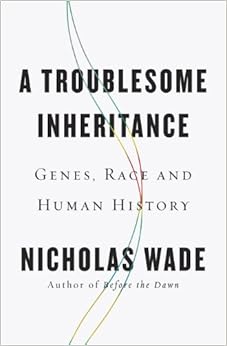
I started to worry about my choice to read A Troublesome Inheritance by Nicholas Wade as soon as I began the preface, which detailed the controversies surrounding the book. Despite my hesitation, I soldiered on.
Wade sets out to challenge the idea that race is solely a social construct, and he aims to show that there are genetic differences between different races (geographical groups or clines) of humans. The author argues that humans are still evolving and have done so since the time humans started to separate geographically. I think most biologists would agree with this premise; a recent story in Science confirms that humans are still evolving in an observable way. If this idea is true, then there should be genetic differences between the human populations that resulted from this geographical separation. What makes this topic "troublesome", of course, is that the history of scientists attempting to understand race in a biological context has been fraught with prejudice, to say the least. Wade acknowledges these concerns and says that he thinks that any genetic differences between races cannot and should not be the basis for a judgment about the worth of one group over another. However, he then proceeds to speculate on why European populations have fared so much better in economics and history than Asian and African populations; he concludes that Europeans simply have higher IQs and stronger work ethics. These conclusion led many scientists to criticize his work as scientifically inaccurate (some of the best examples are here, here, and here). In a style typical of James Watson, Wade essentially dismissed his critics as PC police.
I expected the book to detail what exact genes are found to differ between human populations. I figured these genes would be interesting, but biologically unimportant. Unfortunately, Wade gives only a few specific examples, which I will discuss here with more detail. He starts with the genes MC1R and SLC24A5; variations in these genes are linked to changes in skin and hair color and affect the ability to absorb vitamin D from the sun. I discussed MC1R extensively in my post about red hair; MC1R essentially initiates a cascade of cellular events that turns on the production of pigment synthesizing genes. Likewise, SLC24A5 also affects melanin pigment production (Science 2005). Single nucleotide polymorphisms (SNPs), such as the A111T allele, are found in 98-100% of the SLC24A5 genes sequenced in European populations.
 |
| Graphical Abstract from Kamberov et al., 2012 (Cell) |
A surprising phenotypic difference in East Asian populations is the presence of dry ear wax, which is caused by variants in the ABCC11 gene, which encodes a protein transporter that helps the cell transport various substances across cellular membranes. SNPs in ABCC11 are also linked with decreased body odor (find out more on the Discover Magazine Gene Expression blog). In this case, scientists argue that changes in ABCC11 were caused either by the advantage of lacking body odor in sexual selection or the advantage of decreased body odor in a cold environment; the ear wax phenotype was merely a hitchhiker.
In the end, I was disappointed that the book discussed so few genetic variants and did not detail these genes very well. There is a definitely an interesting topic here; unfortunately, A Troublesome Inheritance is not the place to read about it. Perhaps if Wade (a science writer for the New York Times and Nature) had enlisted the assistance of a anthropologist or a population geneticist, the book would be more successful. I have started writing a follow-up post on this topic; in particular, I
want to address these genetic differences in light of advances in genome sequencing and personal genomics.
No comments:
Post a Comment
Note: Only a member of this blog may post a comment.